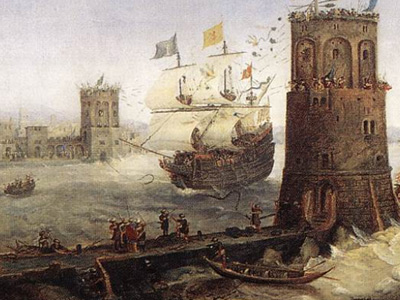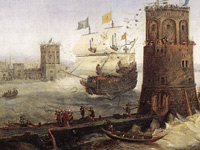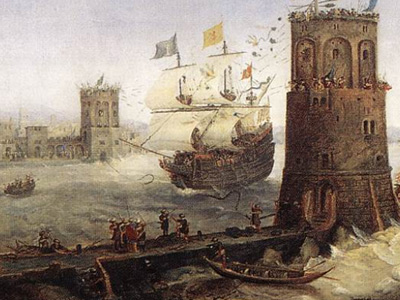Fifth Crusade (1213–1221)

Campaign
Holy Land
The first to take up the cross in the Fifth Crusade was King Andrew II of Hungary. Andrew and his troops embarked on 23 August 1217, in Split. They were transported by the Venetian fleet, which was the largest European fleet in the era. They landed on 9 October on Cyprus from where they sailed to Acre and joined John of Brienne, ruler of the Kingdom of Jerusalem, Hugh I of Cyprus, and Prince Bohemond IV of Antioch to fight against the Ayyubids in Syria. Until his return to Hungary, king Andrew remained the leader of Christian forces in the Fifth Crusade. In October 1217, the leaders of the crusaders - Masters of Hospitalers, Templars and Teutons The Teutonic Order is a Catholic religious institution founded as a military society c. 1190 in Acre, Kingdom of Jerusalem. The Order of Brothers of the German House of Saint Mary in Jerusalem was formed to aid Christians on their pilgrimages to the Holy Land and to establish hospitals. Its members have commonly been known as the Teutonic Knights, having a small voluntary and mercenary military membership, serving as a crusading military order for the protection of Christians in the Holy Land and the Baltics during the Middle Ages. with the leaders and dignitaries of the crusade - held a war council in Acre, over which King Andrew II presided.
The Teutonic Order is a Catholic religious institution founded as a military society c. 1190 in Acre, Kingdom of Jerusalem. The Order of Brothers of the German House of Saint Mary in Jerusalem was formed to aid Christians on their pilgrimages to the Holy Land and to establish hospitals. Its members have commonly been known as the Teutonic Knights, having a small voluntary and mercenary military membership, serving as a crusading military order for the protection of Christians in the Holy Land and the Baltics during the Middle Ages. with the leaders and dignitaries of the crusade - held a war council in Acre, over which King Andrew II presided.
In Jerusalem, the walls and fortifications were demolished to prevent the Christians from being able to defend the city, if they did manage to reach it and take it. Muslims fled the city, afraid that there would be a repeat of the bloodbath of the First Crusade in 1099.
King Andrew's well-mounted army defeated sultan Al-Adil I at Bethsaida on the Jordan River on 10 November 1217. Muslim forces retreated in their fortresses and towns. The crusaders' catapults and trebuchets did not arrive in time, so they had fruitless assaults on the fortresses of the Lebanon and on Mount Tabor. Afterwards, Andrew spent his time collecting alleged relics. At the beginning of 1218 Andrew, who was very sick, decided to return to Hungary.
Andrew and his army departed to Hungary in February 1218, and Bohemund and Hugh also returned home.
Alliance with the Sultanate of Rum
Later in 1218 Oliver of Cologne arrived with a new German army and the count of Holland William I arrived with a mixed army consisting of Dutch, Flemish and Frisian soldiers. With Leopold and John they discussed attacking Damietta in Egypt. To accomplish this, they allied with Keykavus I, the leader in Anatolia, who attacked the Ayyubids in Syria in an attempt to free the Crusaders from fighting on two fronts.
Egypt
In July 1218 the crusaders began their siege of Damietta, and despite resistance from the unprepared sultan Al-Adil, the tower outside the city was taken on August 25. They could not gain Damietta itself, and in the ensuing months diseases killed many of the crusaders, including Robert of Courçon. Al-Adil also died and was succeeded by Al-Kamil. Meanwhile, Honorius III sent Pelagius of Albano to lead the crusade in 1219 . Al-Kamil tried to negotiate peace with the crusaders. He offered to trade Damietta for Jerusalem, but Pelagius would not accept these offers. After hearing this William I, Count of Holland left the crusade and sailed home. In August or September, Francis of Assisi arrived in the crusader camp and crossed over to preach to Al-Kamil. By November, the crusaders had worn out the sultan's forces, and were finally able to occupy the port.
Immediately the papal and secular powers fought for control of the town, with John of Brienne claiming it for himself in 1220. Pelagius would not accept this, and John returned to Acre later that year. Pelagius hoped Frederick II would arrive with a fresh army, but he never did; instead, after a year of inactivity in both Syria and Egypt, John of Brienne returned, and the crusaders marched south towards Cairo in July 1221. This march was observed by the forces of Al-Kamil, and frequent raids along the flanks of the army led to the withdrawal of some 2000 German troops who refused to continue the advance and returned to Damietta.
By now Al-Kamil was able to ally with the other Ayyubids in Syria, who had defeated Keykavus I. The crusader march to Cairo was disastrous; the river Nile flooded ahead of them, stopping the crusader advance. A dry canal that was previously crossed by the crusaders flooded, thus blocking the crusader army's retreat. With supplies dwindling, a forced retreat began, culminating in a night time attack by Al-Kamil which resulted in a great number of crusader losses and eventually in the surrender of the army under Pelagius.
HISTORY

RESOURCES
This article uses material from the Wikipedia article "Fifth Crusade (1213–1221)", which is released under the Creative Commons Attribution-Share-Alike License 3.0.
© Stories Preschool. All Rights Reserved.









